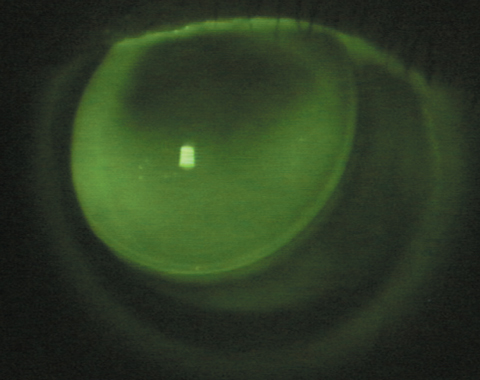 |
Q:
Several scleral lens experts have recommended I use oblate designs instead of prolate designs when I can’t attain good visual acuity with any over-refraction or flexure control in a patient with irregular corneas. Why?
A:
“The terms oblate and prolate describe the shape of the eye as either more flat or more steep in the center, respectively,” Keith Parker, president and CEO of Advanced Vision Technologies, says. “In my opinion, however, regarding scleral lenses, the terms reflect nothing more than marketing hype. There is no difference between them except for a shallower sagittal depth” in an oblate design. And that’s the key to a successful fitting for some patients.
Consider the Consequences
“Many [prolate] scleral lens designs traditionally generate increased sagittal depth to fit deeper eyes such as those with advanced keratoconus by using increasingly steep base curves,” says Jason Jedlicka, OD, clinical associate professor and chief of the Cornea and Contact Lens Service at the University of Indiana. “While this accommodates the lens fitting, as lens base curves become steeper the tear layer behind the lens becomes increasingly convex, adding a high degree of plus power to the system.”
When you compensate for the higher plus power with a higher minus power, it in turn impacts the quality of vision, Dr. Jedlicka says. “Whether due to image minification, optics set further from the corneal plane or a slight increase in higher-order aberrations, visual acuity can be reduced in high minus power scleral lenses in some instances.”
Thus, “with a higher sagittal depth, the tear layer may create more distortion due to the increased prismatic effect of the optical path,” Mr. Parker says.
Solving the Problem
Oblate designs, however, incorporate flatter base curves—often leading to better quality of vision.
“Flatter base curves allow lens powers to be significantly lower, often close to plano, as the vision is corrected with the tear layer under the lens,” Dr. Jedlicka says. “Because of the reduced lens power and since the lens center can be set closer to the corneal plane, the impact of minification is reduced.” As a result of this and the potential for a larger optic zone (which can be achieved due to the lower lens power), he says higher-order aberrations can also be mildly reduced.
 |
| By incorporating flatter base curves, oblate scleral lenses can improve quality of vision. Photo: Shelley I. Cutler, OD |
“Flatter base curves and lower minus powers always give better vision and less distortion,” says Chris Sindt, OD, clinical professor of ophthalmology and visual sciences at the University of Iowa. “For example, if I could go from a 55.00D base curve to a 45.00D base curve, I could take a -10.00D power to plano, but the converse is true, too. If the patient were aphakic, I could go from a +10.00 to +20.00, which could lead to worse vision.” According to Mr. Parker, “a flatter base curve on high minus patients may help with the overall power needed for the final Rx.”
According to Mr. Parker, a flatter base curve is also often used in conjunction with the shallower sagittal depth, which also helps to improve vision. “Remember, the base curve does not dictate the sagittal depth; it is the curves beyond the base curve that have the most significant effect on sagittal depth,” he says.
At the end of the day, Dr. Sindt says, these cases “entirely depend on the disease and cornea below the lens.” One lens design may work better than the other, and knowing how the design will affect the optics is key to choosing the right one.

